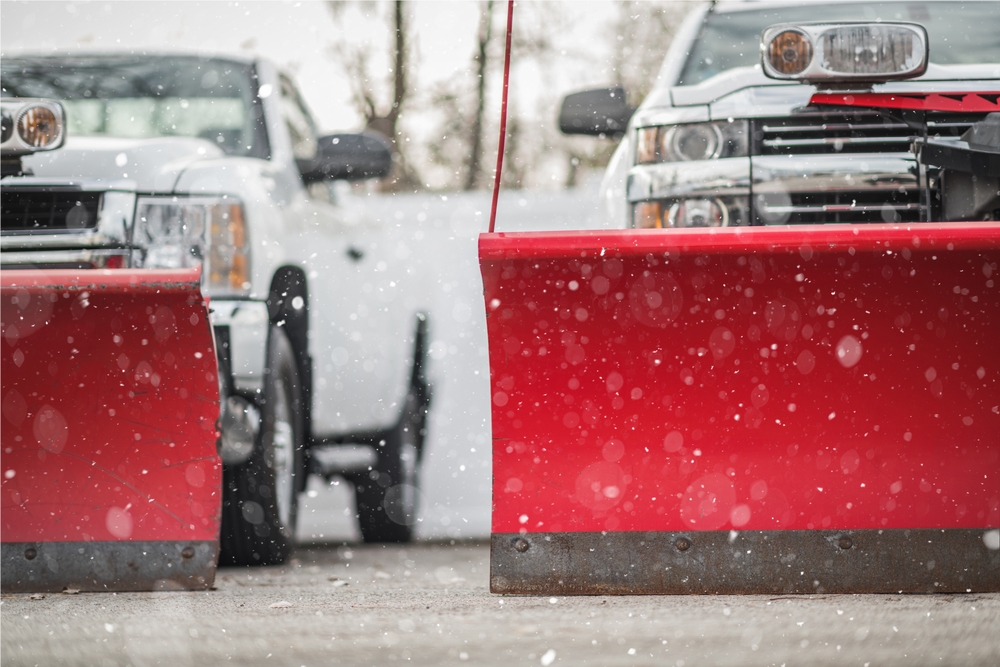Winter may be seasonal—but compliance is all year. Whether you run a municipal fleet, a property management crew, or a snow-and-ice SMB that scales up every November, understanding the rules of the road (and the lot) keeps your team safe, your equipment productive, and your business protected. This guide distills the essentials: how regulations typically apply to plow trucks and spreaders, what to check before the first snowfall, and where snow operations are headed next.
Quick note: Regulations vary by state, municipality, and road class. Use this as a practical framework, then confirm specifics with your local DOT, environmental agency, and insurer.
1) Vehicle Setup: Size, Weight, and Visibility
Width & Overhang
- Federal width limit for most highways is 102 inches (8'6"). Many states provide seasonal or operational exemptions for plows in active snow removal.
- Transport mode vs. plow mode: Your truck might be legal when the blade is angled or removed for transport, but not when straight and mounted for travel. Train operators on when to angle or remove the blade between sites.
GVWR, Axle Loads, and Bridge Laws
Plows, wings, wet kits, spreaders, and full hoppers add serious weight. Verify:
- GVWR and rear/steer axle ratings aren’t exceeded with your typical salt load and fuel.
- Tire load indexes match the job; winter service tires often carry specific speed/load constraints.
- Bridge formula compliance for larger tandems and tri-axle setups (especially on interstates).
Lighting & Marking
- Mount auxiliary headlamps above the blade if the plow blocks OE headlights when raised.
- Use SAE Class 1 amber beacons or lightbars for maximum conspicuity in storms and during lot work.
- Ensure reflective tape on the plow blade edges and the rear of spreaders.
- Confirm backup alarms work and meet local dB requirements (many municipalities require them on commercial lots and job sites).
Mirrors, Cameras & ADAS
- Snow, brine, and road grime defeat sensors. Keep heated mirrors, rear/bed cameras, and radar/ultrasonic sensors clean and calibrated.
- If your truck has ADAS (lane-keep, AEB), note that reduced visibility can disable assistance; operators must understand the limits.
2) Operator Requirements: Licensing, Hours, and Safety
Licensing (CDL vs. Non-CDL)
- Most ¾-ton and 1-ton pickups with front plows run non-CDL.
- Add air brakes, heavier tandem axles, or a loaded trailer and you may cross into CDL territory. Confirm the combined rating (GCWR), not just curb weight.
Hours of Service (HOS)
- During declared winter emergencies, some states provide temporary HOS flexibility for essential snow removal.
- Outside emergencies, follow standard HOS rules where applicable, or your state’s intrastate equivalent for commercial operations.
PPE & Safety Training
- Require high-visibility outerwear, winter slip-resistant boots, insulated gloves, and eye/ear protection for maintenance tasks.
- Train on site hazard mapping (curbs, wheel stops, fire hydrants), speed control, spotter use, and communication protocols in low visibility.
3) Equipment Standards: Plows, Spreaders, and Maintenance
Plow Hardware
- Use curb guards and shoes to control cutting depth and reduce infrastructure damage.
- Keep cutting edges in good condition; uneven wear impacts control and increases trip-edge strikes.
- Hydraulic line inspection is critical—leaks create environmental risk and traction hazards.
Spreaders & Liquid Systems
- Verify calibration (lbs/acre, gal/acre). Over-application risks citations on sensitive properties and adds cost.
- Tank restraints must meet your state’s transport standards; unsecured liquid mass shifts can destabilize the vehicle.
Preventive Maintenance
- Pre-season: cooling system, batteries, alternators, starters, PTOs, plow frames, mount points, and electrical grounds.
- In-season: anti-corrosion washes (including undercarriage), dielectric grease on connectors, and torque checks on mounts after impact or heavy storms.
4) Environmental Compliance: Salt, Brine, and Storage
Application Practices
Many jurisdictions publish Best Management Practices (BMPs) for winter maintenance. Common elements:
- Pretreat with brine to reduce total salt use.
- Targeted spot applications instead of blanket spreading.
- Temperature-based decisions: rock salt loses effectiveness below ~15°F (−9°C); consider brine additives or abrasives when it’s extremely cold.
Storage & Containment
- Store salt under cover with contained runoff; uncovered piles often violate stormwater rules.
- Keep liquids in secondary containment and inspect valves and lines regularly.
Recordkeeping
- Track application rates, materials, temperatures, and outcomes. Some municipalities require logs; even when they don’t, records help defend against slip-and-fall claims and prove BMP adoption.
5) Site Contracts, Liability & Insurance
Contracts that Protect You
- Use clear scopes (trigger depths, target service levels, de-icing expectations), response times, and weather data sources (e.g., nearest DOT station).
- Add indemnification, limitations of liability, and documentation requirements (time-stamped photos, logs).
Insurance Basics
- Review auto liability, general liability, inland marine (for spreaders and implements), and workers’ comp.
- Ask carriers about snow plow endorsements and completed operations coverage for post-storm claims.
Incident Response
- Establish a post-incident protocol: immediate scene photos, witness names, preservation of application logs, and notification steps.
- Train crews to report near-misses to prevent repeats.
6) Municipal vs. Private Work: What Changes?
Public Right-of-Way
- Expect stricter rules on lighting, width, and escort needs for oversized municipal rigs.
- Many municipalities require operator certifications or approved vendor status, including background checks and additional insurance.
Private Lots & Campuses
- Property owners may set house rules (no windrows blocking ADA ramps, designated snow storage zones).
- Hospitals, schools, and industrial sites often require badging, safety briefings, and proof of BMP training before you plow.
7) Pre-Season Compliance Checklist
- Verify GVWR/axles/tires with full winter upfit and typical load.
- Mount auxiliary headlamps, check amber beacons and reflective markings.
- Update DOT numbers, registration, IFTA (if applicable), and state permits for heavier rigs.
- Confirm CDL needs for specific trucks/trailers.
- Refresh operator training: safe plowing speeds, transport rules, site maps, and ADAS limitations.
- Calibrate spreaders/briners; document rates.
- Inspect hydraulics, mounts, frames, edges, and electrical.
- Audit salt/liquid storage for cover and containment.
- Review contracts, COIs, and incident response playbook.
- Set up telematics rules (geofences, idling limits, speed alerts, material usage tracking).
8) Telematics, Data & Documentation (Your Quiet Compliance Superpower)
Modern plow fleets increasingly rely on GPS + material sensors to log: start/stop times, routes, plow position (up/down), spreader rates, pavement and air temps, and photos. Benefits include:
- Proof of service for customers and courts.
- Right-sizing salt use to meet BMPs and reduce corrosion.
- Lower insurance premiums with validated safety policies.
- Faster training via post-storm playback.
If you’re not using telematics yet, start with route tracking and application logging, then layer in weather integrations and camera capture.
9) Future Trends to Watch
Smarter, Cleaner Powertrains
- Gas and diesel still dominate heavy plowing, but expect more mild-hybrid and plug-in support vehicles for sidewalks and light-duty routes.
- Anti-corrosion packages and sealed connectors are improving upfit durability across brands.
Precision Winter Maintenance
- Closed-loop spreaders using ground speed and friction sensors to auto-adjust rates.
- Pavement temperature sensing (infrared or embedded) feeding route-by-route decisions.
- Optimized brine blends to expand the effective temp window and reduce chloride load.
Automation & Safety
- Driver-assist cues in white-out conditions, geofenced speed caps in lots, and collision-avoidance overlays purpose-built for plow operations.
- Gradual introduction of semi-autonomous sidewalk/lot robots for campuses and logistics yards.
Compliance by Design
Expect more data-driven requirements from municipalities: logged application rates, calibrated spreaders, and storm-by-storm reports as a condition of contract awards. Fleets that can prove performance will win more RFPs.
How Kunes Commercial Can Help
- Spec-Right Upfits: We’ll match plow, wing, and spreader choices to your chassis’ GVWR, axle ratings, and front-end capacity—before you invest.
- Lighting & Visibility Packages: SAE Class 1 beacons, auxiliary headlamps, heated mirrors, and camera kits installed and tested.
- Corrosion-Smart Builds: Undercoating, sealed harnesses, dielectric protection, and stainless hardware where it matters.
- Telematics & Compliance Tools: GPS/material tracking, driver scorecards, and service-proof workflows to simplify bids and audits.
- Season-Ready PM Plans: Pre-season inspections, in-season fast-track repairs, and parts on hand when storms stack up.
Let’s Build a Safer, Compliant Snow Fleet
If you’re gearing up for the season—or rethinking your specs after a tough winter—Kunes Commercial can help you navigate width limits, weight math, lighting, storage, and documentation without slowing your operation. Tell us about your routes, typical storm profile, and service level targets, and we’ll propose a build and maintenance plan that keeps you compliant, efficient, and ready for whatever the radar throws your way.

